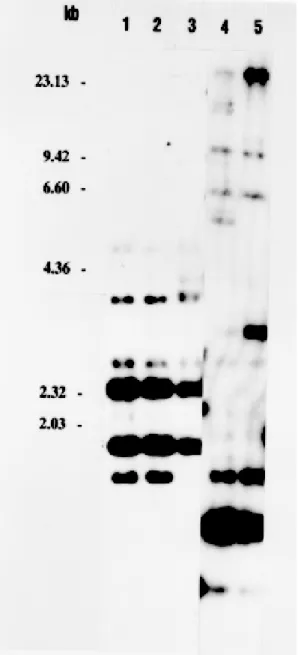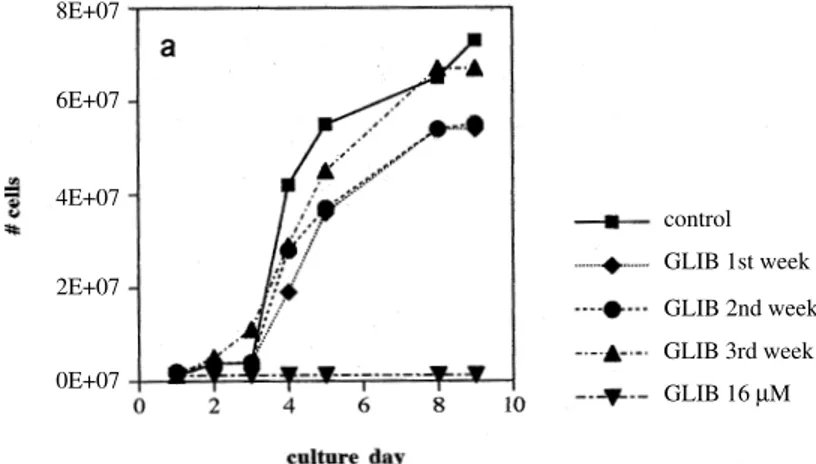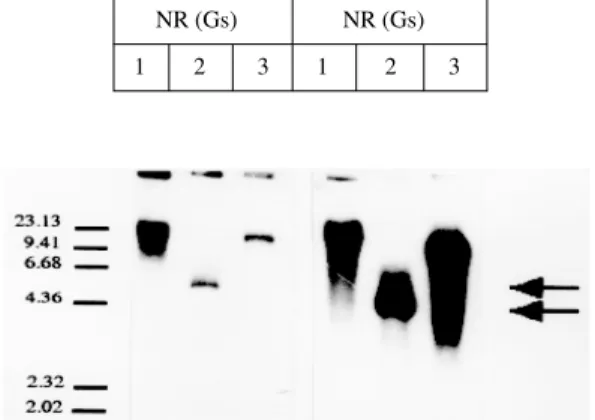601 601 601 601 601 Mem Inst Oswaldo Cruz, Rio de Janeiro, Vol. 92(5): 601-606, Sep./Oct. 1997
Sensitivity of
Leishmania
spp
.
to Glibenclamide and
4-Aminopiridine: A Tool for the Study of Drug Resistance
Development
Alicia Ponte-Sucre, Yelitza Campos
*, Jorge Vázquez, Heidrun Moll
**,
Alexis Mendoza-León
*/+Laboratorio de Fisiología Molecular, Instituto de Medicina Experimental, Universidad Central de Venezuela, Apartado 68256, Caracas 1062-A, Venezuela *Laboratorio de Bioquímica y Biología Molecular de Parásitos, Instituto de Biología Experimental, Universidad Central de Venezuela, Apartado 47577, Caracas 1041A, Venezuela **Zentrum für Infektionsforschung, University of Würzburg, Röntgenring 11, Würzburg, D-97070,
Germany
We have demonstrated that Leishmania spp. grown as promastigotes, are sensitive to the K+ channel inhibitors 4-aminopyridine and glibenclamide. Their host cells, the macrophages, are not affected by similar concentrations of the drugs. We have also initiated the molecular characterization of the mecha-nisms involved in the development of drug resistance to glibenclamide by the parasite. Therefore, we have selected experimentally and begun to characterize the Venezuelan Leishmania (Leishmania) strain, NR resistant to glibenclamide [NR(Gr)]. The analysis of genomic DNA evidenced the existence of a fragment which apparently is amplified in NR(Gr). The fragment recognized by the pgpA probe, related to the Leishmania P-glycoprotein family and which was originally isolated from L. tarentolae, showed a size polymorfism between the sensitive and the resistant strain. These results suggest that the develop-ment of resistance to glibenclamide in the strain NR(Gr) might be associated with the amplification of the ltpgpA or related gene(s).
Key words: Leishmania - chemotherapy - glibenclamide - 4-aminopyridine - drug resistance - P-glycoprotein
Leishmaniasis is a disease with different clini-cal manifestations. The toxicity of conventional drugs such as the antimonials, and the possible development of resistance by the parasite to such compounds, emphasize the importance of the search for alternative strategies, both for its pre-vention and its treatment (Olliaro & Bryceson 1993). The accurate and early diagnoses of the dis-ease, and its effective control, are extremely im-portant and must be adequately addressed.
From the chemotherapeutic point of view, the development and evaluation of new drugs is mainly based on their efficacy against parasites. Such ac-tivity is sometimes opposed either by the complex life cycle of the parasite or by the intracellular na-ture of the developmental stages of the organisms
This work was partially supported by the Venezuelan grants CDCH-UCV 09.33.0018.96, PC.09.010.94, 03.10.3750.96, 09.33.3514.95, CONICIT RPIV-110034 S1-96001411 and S1-2674 and the German Bundes-ministerium für Forschung and Technologie grant K I8906.
+
Corresponding author. Fax: +58-2-753.5897 Received 11 November 1996
Accepted 11 June 1997
as happens in Leishmania (Olliaro & Bryceson 1993). In this work we have attempted to evaluate the effect of 4-aminopyridine and glibenclamide, two classical inhibitors of K+ channels, on the vi-ability of Leishmania promastigotes and analyze some of the molecular mechanisms involved in the development of resistance to glibenclamide.
MATERIALS AND METHODS
Drugs - The drugs used were the classic K+ channel inhibitors 4-aminopyridine (4-AP) for voltage gated channels, and glibenclamide (GLIB) for ATP gated channels. 4-AP was dissolved in deionized water to 0.5 M and GLIB was dissolved in ethanol to 4 x 10-3 M. Both drugs were further diluted in Schneider’s Drosophila medium to the desired concentrations. As GLIB has an afinity for serum albumin greater than 96%, a correction has to be done to estimate the free drug concentration in the medium. Such estimation was done using the methodology described by Bennet et al. (1996). 4-AP does not have a high affinity for serum pro-teins as albumin thus, the free drug concentration in the medium is considered to be the same added.
602 602 602 602
602 Drug Resistance in Leishmania to K+ Channel Blockers • A Ponte-Sucre et al.
isolated in 1980 from a Venezuelan patient with tegumentary diffuse leishmaniasis and was kindly provided by Dr Angel Hernández, Instituto de Biología Celular, Universidad Central de Venezu-ela. Its identification was carried out in this study by RFLP analysis of the ß-tubulin gene region as previously described (Mendoza-León et al. 1995). The leishmanicidal activity of the compounds was studied in Leishmania NR promastigotes cul-tured in Schneider’s Drosophila medium (GIBCO) supplemented with 10% fetal calf serum. The para-sites were harvested at their stationary-phase of growth, the cell suspension was adjusted to a den-sity of 2 x 106 cells ml-1 in a final volume of 0.1 ml of fresh medium. Aliquots of stationary-phase
Leishmania were then exposed to various concen-trations of the drug (i.e., 10-10-10-2 M) at room temperature for 2 or 4 hr. Subsequently, the num-ber of live cells was estimated in each experimen-tal vial and compared to the number of live cells of control vials incubated without drugs. The viabil-ity of Leishmania was determined by a modifica-tion of a previously described procedure (Jackson et al. 1985). At the end of the incubation time, the cells were washed twice in phosphate buffer (PBS), resuspended in the same buffer at the same den-sity, stained for 2 min at 25°C with 125 µg ml-1 fluorescein diacetate and observed with a Nikon fluorescence microscope at 495 nm. The results are expressed as the percentage of live parasites at each drug concentration.
The isolation of a resistant Leishmania strain was assayed in three isolates of New World Leish-mania, i.e., the Venezuelan strains NR, 9012 and AZV, all of them from the subgenus Leishmania
(Table), and one from the Old World, L. (L.) major
P. The strains were serially cultured at increasing
concentrations of GLIB (5 µM to 100 µM). At each concentration step, the cells remained at least three weeks. The development of resistance was moni-tored comparing the growth of experimental and control cells grown in parallel.
Molecular analysis - The DNA isolation from
sensitive and resistant Leishmania, their restriction analysis, as well as the DNA labelling and hybrid-ization conditions were carried out as described by Mendoza-León et al. (1995). The pgpA probe, a genomic fragment of 800 bp from L. tarentolae, present in the recombinant clone PM12, recognizes the P-glycoprotein (P-gp) family of Leishmania
(Légaré et al. 1994). Following the digestion of the plasmid pM12 with the restriction enzyme Sac I and the fragment separation, the pgpA probe was recovered from the agarose gel and purified by the Wizard DNA purification System (Promega).
RESULTS
We have evaluated the effect of the K+ channel inhibitors on stationary-phase promastigote cul-tures of the Venezuelan strain NR. This strain was identified as a member of the Leishmania subge-nus by the polymorphism of the ß-tubulin region (Fig. 1).
Previously, we have demonstrated that Leish-mania strains are sensitive to K+ channel inhibi-tors (Ponte-Sucre et al. 1995). A typical dose-re-sponse curve obtained for the viability of the strain NR is illustrated in Fig. 2. Both K+ inhibitors, 4-AP and GLIB, affect the viability of the promastigotes along their stationary phase of growth. The LD50 for 4-AP was 39 µM and for GLIB was even smaller, i.e., 7 µM.In addition, we have demonstrated that although the infection of the macrophage cell line J774 and
peritoneal-exu-TABLE
Designation of Leishmania species
Subgenus Speciesa Strain designationb Abbreviation Origin
Leishmania (L.)
mexicana MNYC/BZ/62/M379 M379 Belize
amazonensis IFLA/BR/67/PH8 PH8C5 c Brazil
major MRHO/SU/59/P-strain P USSR
unknownd
MHOM/VE/72/AZV AZV Venezuela
MHOM/VE/80/NR NR Venezuela
MHOM/VE/90/LCP9012 9012 Venezuela
Viannia (V.)
braziliensis MHOM/BR/75/M2903 M2903 Brazil
guyanensis MHOM/BR/75/M4147 M4147 Brazil
603 603603 603603 Mem Inst Oswaldo Cruz, Rio de Janeiro, Vol. 92(5), Sep./Oct. 1997
date macrophages by L. (L.) major is not signifi-cantly decreased by concentrations of the drugs 3-4 times smaller than the promastigote LD50,464 µM 4-AP and 10 µM GLIB for this strain, the sur-vival of intracellular parasites decreased signifi-cantly in the presence of these drugs without af-fecting the viability of the macrophages (data not shown). For instance, a concentration of 3 µM GLIB, affects the viability of the macrophages less than 5%.
In view of these results and trying to under-stand the response of the parasite against these drugs, we further attempted to select and molecu-larly characterize a Leishmania strainresistant to GLIB (Gr). Of the three isolates of New World
Leishmania, NR, 9012 and AZV, and the one from the Old World L. (L.) major P, used for the drug resistance selection,only the strain NR survived at concentrations higher than 11 µM (Gr); the rest of the isolates remained sensitive to the drug at concentrations higher than 8 µM (Gs). The maxi-mum concentration of GLIB used to select the iso-late NR(Gr) was 16 µM. Fig. 3a illustrates the be-havior of the strain NR cultured at GLIB 3 µM for three consecutive weeks, and the succesful selec-tion of the resistant strain. It can be observed that by the third week both control (Gs) and selected (Gr) cells had growing curves which were rather similar. At this stage, the parasites grown at GLIB 3 µM were serially subcultured at increasing
con-Fig. 1: Leishmania identification. Genomic DNA from New World Leishmania was digested with the endonuclease Pst I, fractionated on 1% agarose gel, and transferred to a nylon mem-brane. The blot was hybridized at medium stringency condi-tions (2x SSC, 0.1% SDS 2X Denhardt solution, 100 µg/ml calf thymus DNA, 67°C) to the Leishmania ß-tubulin clone pLgß4. L. (L.) mexicana M379 (lane 1), L. (L.) amazonensis
PH8C5 (lane 2) L. (V.) braziliensis M2903 (lane 4) and L. (V.)
guyanensis M4147 (lane 5), were used to identify the Venezu-elan L. (L.) NR strain (Lane 3). Molecular weight markers are from the Hind III digestions of λ-DNA.
604 604 604 604
604 Drug Resistance in Leishmania to K+ Channel Blockers • A Ponte-Sucre et al.
centrations of the drug, up to 16 µM (Fig. 3b). Fig. 3a also demonstrates the susceptibility of the sen-sitive parasites to GLIB 3 µM and 16 µM. The effect of GLIB 16 µM on the NR(Gr) strain, com-pared to the susceptibility of the NR(Gs) strain is illustrated in Fig. 3b. These results demonstrate that
the viability of the resistant strain selected in the laboratory is not impaired at this drug concentra-tion.
An analysis of the genomic DNA of cells both of NR(Gs) and NR(Gr) was then done. DNA from both strains was digested with different restriction
Fig. 3: sensitivity of the Venezuelan strain Leishmania (L.) NR strain (sensitive to glibenclamide) to glibenclamide 3 µM ( ) and 16 µM (t) and development of resistance by NR to GLIB 3 µM at week 2 ( ) and 3 (s) of subculture (a) and number of alive
Leishmania (L.) NRcells per field in a sensitive strain NR(Gs) under control conditions and number of alive NR cells in a resistant strain NR(Gr) exposed to GLIB 16 µM (b). Magnification 400 x.
8E+07
6E+07
4E+07
2E+07
0E+07
control
GLIB 1st week
GLIB 2nd week
GLIB 3rd week
605 605605 605605 Mem Inst Oswaldo Cruz, Rio de Janeiro, Vol. 92(5), Sep./Oct. 1997
enzymes such as Bam HI, Pst I and Hind III, and hibridized at low Cot conditions to a pgpA probe from the Leishmania P-gp genes (related to the resistance to arsenite and antimonials). As illus-trated in Fig. 4, when Pst I is used as the restriction enzyme, there is a polymorfism in the size of the fragment recognized in NR(Gs) (6.2 Kb) and NR(Gr) (4.4 Kb) by the probe. Since the same amount of genomic DNA was used, these results suggest that this fragment seems to be amplified in the strain NR(Gr).
(PgpA) has been associated (Légaré et al. 1994). The fact that both 4-AP and GLIB are deleterious to cultured promastigotes, have low DL50 and do not seem to impair the macrophage survival at con-centrations where the survival of intracellular amastigotes decreased significantly (data not shown), reflects the importance of understanding the response and mechanism of action of these transport inhibitors. In this work we have begun to study the response of the parasite against these drugs and to acknowledge the molecular mecha-nisms involved in the development of GLIB resis-tance. For this study we have used the Venezuelan
Leishmania (L.) NR strain, a member of the Leish-mania subgenus. We have selected and began the characterization of Leishmania (L.)NR resistant to GLIB [NR(Gr)]. Thus, we found that NR(Gr) survived at concentrations higher than 11 µM as the fraction of free drug present in the medium. Its viability is not impaired at a GLIB concentration of 16 µM, although the viability of the sensitive strain, NR(Gs), is dramatically affected by this drug concentration. Striking was the strong signal found, independent of the restriction enzymes tested, for the pgpA in NR(Gr) in the Southern analysis. Since equal amounts of DNA was used, these results sug-gest an amplification of sequences related to pgpA in the GLIB resistant strain. The pgpA probe was originally characterized as the nucleotide binding site (nbs) of the gene family of P-glycoproteins in
Leishmania (Ouellette et al. 1990, Légaré et al. 1994). Whether the resistance found could be re-lated to the amplification of genes associated to P-glycoproteins is an open question. Amplification of particular gene sequences in response to drug pressure has been well documented in Leishma-nia; however, many of these amplifications are un-related to drug resistance (Beverly 1991). There-fore is worthy to continue to explore the biochemi-cal and molecular mechanisms which determine the response of the parasite to this drug and the development of resistance by this strain. On the other hand, there is a size polymorphism for the Pst I-fragment recognized by pgpA both in NR(Gs) (6.2 Kb) and NR(Gr) (4.4 Kb). The comparison of a partial DNA sequence of the polymorphic frag-ment from both strains showed more than 95% of homology between them, and around 60% homol-ogy with multidrug resistance genes from Plasmo-dium falciparum’s (not shown). We do not have yet an explanation for it; nevertheless, internal gene rearrangements has been postulated as one mecha-nism where by it could arise; to answer this ques-tion we are currently working on the restricques-tion map and final DNA sequence of the fragment from both strains.
NR (Gs) NR (Gs)
1 2 3 1 2 3
Fig. 4: southern blot analysis of pgpA sequences in Leishma-nia. Genomic DNA from the Venezuelan Leishmania (L.) NR strain (Gs) and (Gr) was digested independently with the en-zymes Bam HI (1), Pst I (2) and Hind III (3), fractionated on a 1% agarose gel and transferred to a nitrocellulose blot. The blot was hybridized to the pgpA probe under low stringency condi-tions. The arrows show the size polymorphism of the fragment obtained by the restriction analysis with Pst I.
DISCUSSION
The study of ion channels in parasites such as
606 606 606 606
606 Drug Resistance in Leishmania to K+ Channel Blockers • A Ponte-Sucre et al.
ACKNOWLEDGMENTS
To Dr M Ouellette for the generous gift of the pgpA probe.
REFERENCES
Aguilar-Bryan L, Nichols CG, Wechsler SW, Clemant IV JP, Boyd III E, González G, Herrera-Sosa H, Nguy K, Bryan J, Nelson D 1995. Cloning of the ß-cell high-affinity sulphonylurea receptor: A regula-tor of insulin secretion. Science 268: 423-426. Bakker-Grunwald T 1992. Ion transport in parasitic
pro-tozoa. J Exp Biol172: 311-322.
Bennet L, Oie S, Schwartz JB 1996. Design and optimi-zation of dosage regimens; pharmacokinetic data, p. 1707-1711. In L Goodman, A Gilman (eds). The Pharmacological Basis of Therapeutics, 9th ed., McGraw Hill, New York.
Beverly S 1991. Gene amplification in Leishmania. Ann Rev Microbiol 45: 417-444.
Castle N, Haylett D, Jenkinson D 1989. Toxins in the characterization of potassium channels. Trends in Neuroscience12: 59-65.
Jackson P, Pappas M, Hansen B 1985. Fluorogenic sub-strate detection of viable intracellular and extracel-lular pathogenic protozoa. Science 227: 435-438. Lainson R, Shaw JJ 1987. Evolution, classification and
geographical distribution, p. 1-120. In W Peters, R Killick-Kendrick (eds). The Leishmaniases in Biol-ogy and Medicine, Academic Press, London. Légaré D, Hettema E, Ouellette M 1994. The
P-glyco-protein-related gene family in Leishmania. Mol Biochem Parasitol 68: 81-94.
Mendoza-León A, Havercroft J, Barker D 1995. The RFLP analysis of the ß-tubulin gene region in New World Leishmania. Parasitology 111: 1-9. Olliaro PL, Bryceson A 1993. Practical progress and new
drugs for changing patterns of leishmaniasis.
Parasitol Today 9: 323-328.
Ouellette M, Fase-Fowler F, Borst P 1990. The ampli-fied H circle of methotrexate-resistant Leishmania tarentolae contains a novel P-glycoprotein gene.
EMBO J 9: 1027-1033.
Panten U, Burgfeld J, Goerke F, Rennicke M, Schwanstecher M, Walasch A, Zücker B, Lenzen S 1989. Control of insulin secretion by sulphonylureas, meglitinide and diazoxide in relation to their bind-ing to the sulphonylurea receptor in pancreatic is-lets. Bioch Pharmacol 38: 1217-1229.
Ponte-Sucre AI, Fernández M, Mendoza-León A 1995. The effect of ionic channel inhibitors on the growth and viability of Leishmania subgenus. Abstract 345. Molecular Parasitology Meeting, Woods Hole, Mass., USA.


